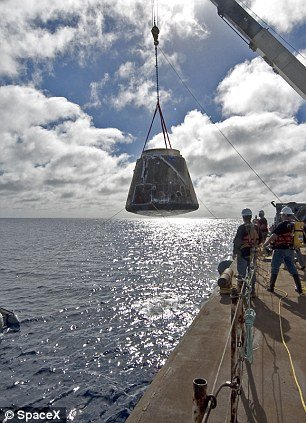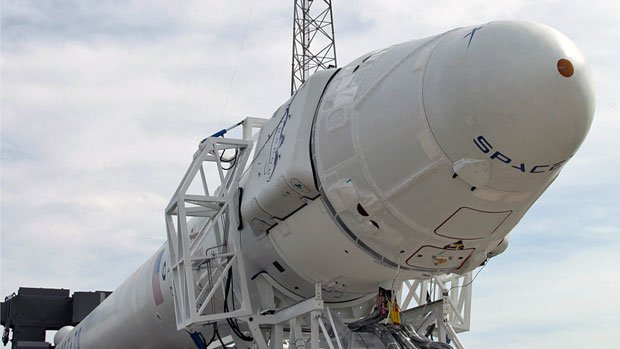Home Tags Posts tagged with "Dragon"
Dragon
The first commercially contracted re-supply mission to the International Space Station (ISS) has begun.
A Falcon rocket carrying a Dragon cargo capsule lifted clear of Cape Canaveral in Florida at 20:35 (00:35 GMT).
The robotic Dragon ship will deliver 400 kg of food, clothing, experiments and spares to the orbiting platform’s six astronauts.
It is the maiden flight in a sequence of 12 missions that California’s SpaceX company is performing for NASA.
NASA is looking to the private sector to assume routine transport duties to and from low-Earth orbit.
It has given SpaceX a $1.6 billion contract to keep the ISS stocked up with essentials, restoring a re-supply capability that the US lost when it retired the shuttles last year.
The terms of the contract kicked in following a successful test of Dragon’s systems in May.
That demonstration saw the capsule berth with the ISS – the first commercially designed and built vehicle to do so – and then return safely to Earth.
NASA has a second company it hopes also can soon begin operational cargo deliveries to the station.
The Orbital Sciences Corporation (OSC) will shortly test its new Antares rocket before undertaking its own ISS demonstration with a robotic vessel called Cygnus.
If that mission – tipped to take place next year – goes well then it will trigger a $1.9 billion contract for Orbital.
NASA wants eventually to put astronaut transport in the hands of the private sector, too.
SpaceX is eyeing this business as well, and is developing the critical life-support and safety systems that would turn Dragon into a human-rated vehicle. The company says it is just a few years away from being able to provide an astronaut “taxi” service.
NASA’s policy of outsourcing its cargo and crew transport needs is intended to find savings that can be ploughed back into building a rocket and capsule system capable of taking humans beyond low-Earth to more challenging destinations.
“We’re handing off to the private sector our transportation to the International Space Station so that NASA can focus on what we do best – exploring even deeper into our Solar System, with missions to an asteroid and Mars on the horizon,” explained agency administrator Charles Bolden.
Sunday’s nine-minute, 14-second ascent to orbit appeared flawless.
The Falcon dropped the Dragon off in an elliptical path running from 197 km above the Earth out to 328 km.
“Dragon was inserted into a picture-perfect orbit,” said SpaceX president Gwynne Shotwell.
“Its solar arrays deployed and it’s driving its way to station. So, that’s just awesome.”
Dragon must raise itself to the ISS’s altitude, which is presently at more than 400 km.
It is scheduled to arrive at the station on Wednesday. It will follow the routine established in May of parking itself just below the platform so that it can be grabbed by a robotic arm and pulled into a berthing port.
The attachment should take place at about 05:40 GMT.
Dragon is expected to return to Earth at the end of the month.
Its cargo then will include broken machinery and science materials that need to be handed back to researchers.
SpaceX Dragon cargo capsule has splashed down in the ocean off the California coast.
The return to Earth completes a historic first mission to the International Space Station (ISS) by a privately operated vehicle.
Impact with the water was confirmed at 08:42 Pacific Daylight Time.
Fast boats positioned in the splashdown zone were despatched to recover the unmanned capsule.
Early data suggested Dragon came down very close to its targeted location about 900 km (560 miles) from the Baja Peninsula.
The mission was intended as a demonstration of the freight service SpaceX plans to run to the platform.

SpaceX Dragon cargo capsule has splashed down in the ocean off the California coast
It took half a ton of food and supplies up to the ISS astronauts, and brought down about two-thirds of a ton of completed experiments and redundant equipment.
A successful recovery of the capsule and its contents will trigger a $1.6bn (£1bn; 1.3bn-euro) contract with the US space agency (NASA) for 12 further re-supply trips.
Dragon’s fall to Earth was overseen by controllers at SpaceX’s headquarters in Hawthorne, California, and at NASA’s Johnson Space Center in Houston, Texas.
The journey home began early on Thursday when the vessel was unberthed from the ISS by the station’s 17.5 m (58 ft) robotic arm.
Astronaut Don Pettit, at the controls of the Canadarm2, then released the cargo ship to fly free at 09:49 GMT, just as the station was moving over the Southern Ocean.
Dragon fired its thrusters three times to take itself down and away from the platform. A final 10-minute burn some five hours later committed the capsule to a plunge into the atmosphere.
A range of ships and planes had been organized to track the return, which was slowed in the final minutes by three parachutes.
Once recovered, Dragon will be returned to port, and then transferred to Texas for inspection and for its cargo to be unloaded.
NASA has engaged SpaceX (Space Exploration Technologies Corporation) and another company, Orbital Sciences Corporation of Virginia, to fulfill logistics roles at the ISS.
The agency hopes the contracting out of freight duties will save it money that can then be re-invested in more daring activities beyond the station, at destinations such as asteroids and Mars.
The commercial cargo approach will be followed later this decade by crew transport services.
SpaceX wants this business as well, and is developing the safety and life-support equipment that would allow Dragon to double up as an astronaut taxi.
SpaceX has successfully launched Dragon mission to re-supply the space station, the first cargo delivery to the orbiting outpost by a private company.
The firm’s Falcon rocket, topped by an unmanned Dragon freight capsule, lifted clear of its Florida pad at 03:44 EDT.
The initial climb to an altitude some 340 km above the Earth lasted a little under 10 minutes.
Within moments of being ejected, Dragon opened its solar panels.

SpaceX has successfully launched Dragon mission to re-supply the space station, the first cargo delivery to the orbiting outpost by a private company
It will take a couple of days to reach the station. The plan currently is for the vessel to demonstrate its guidance, control and communications systems on Thursday, at a distance of 2.5 km from the International Space Station (ISS).
If those practice proximity manoeuvres go well, Dragon will be allowed to drive to within 10 m of the station on Friday. Astronauts inside the platform will then grab the ship with a robotic arm and berth it to the 400 km-high structure.
They will empty Dragon of its 500 kg of food, water and equipment, before releasing it for a return to Earth at the end of the month.
The mission has major significance because it marks a big change in the way the US wants to conduct its space operations.
NASA is attempting to offload routine human spaceflight operations in low-Earth orbit to commercial industry in a way similar to how some large organizations contract out their IT or payroll.
The carriage of freight will be the first service to be bought in from external suppliers; the transport of astronauts to and from the station will be the second, later this decade.
The US agency hopes these changes will save it money that can then be invested in exploration missions far beyond Earth, at destinations such as asteroids and Mars.
SpaceX has many new systems it has to demonstrate in the coming days, and has tried to lower expectations ahead of the mission.
NASA has set the California company a series of development milestones. Only when those have been met fully will a $1.6 billion ISS re-supply contract kick in.
The agency is also looking to engage a second cargo partner. Orbital Sciences Corporation of Virginia is slightly behind SpaceX in its development schedule, although it started work on its Antares rocket and Cygnus capsule system later. Orbital expects to fly a first mission to the vicinity of the ISS later this year or early in 2013.
[youtube d_M1I-pt2P8]
The launch of the American SpaceX’s Dragon re-supply mission to the International Space Station (ISS) has been delayed by at least three days.
The company was forced to abort the flight just as its Falcon rocket was about to leave the pad at Florida’s Cape Canaveral Air Force Station.
Early data indicated unusual pressure readings in one of the nine engine combustion chambers under the vehicle.
The company says it hopes to try again on Tuesday or Wednesday.
“We had a nominal countdown, right until about T-minus point-five-seconds,” explained SpaceX president Gwynne Shotwell.
“The engine controller noted high chamber pressure in engine five; software did what it was supposed to do – aborted engine five, and then we went through the remaining engine shut-down,” she told reporters.
“We need to lift off with all nine [engines], which is why we aborted. You can lose up to two engines and still make your mission, just not at lift-off.”

The launch of the American SpaceX's Dragon re-supply mission to the International Space Station (ISS) has been delayed by at least three days
The next earliest launch opportunity is 03:44 EDT on Tuesday.
SpaceX is attempting to become the first private company to send a cargo craft to the ISS; and its Dragon ship, which sits atop the Falcon rocket, has been loaded with half a ton of food and spares for the purpose.
Such unmanned freighter missions have traditionally been performed by government-owned vehicles. But by buying in this service, NASA aims to save money that can then be spent on exploration missions far beyond Earth, to asteroids and Mars.
Both SpaceX and another private firm, Orbital Sciences Corp, have been given billion-dollar contracts by NASA to keep the space station stocked with supplies. Orbital expects to make its first visit to the international outpost with its Antares rocket and Cygnus capsule system later this year.
SpaceX’s mission – when it does eventually get under way – will be the final demonstration of its freight service. If all the mission goals are met to NASA’s satisfaction, the company’s $1.6 billion re-supply contract with the agency will kick in.
SpaceX wants eventually also to ferry astronauts to and from the ISS.
To that end, Dragon has been designed from the outset to carry people; and under another NASA programme, the company is working to develop the onboard life-support and safety systems that would make manned flights feasible.
Following the retirement of the shuttles last year, America has had no means of launching its own astronauts into space – rides must be bought for them on Russian Soyuz rockets at more than $60 million per seat. SpaceX says Dragon could be ready to carry people in 2015 at a seat price of $20 million.
“In order for NASA to be able to afford any programme of exploration in the future given the fiscal realities of the government, it has to transition away from high-cost services that are procured by and for the government into shared-use services that are competitively sourced,” observed Jeff Greason, the president of XCOR Aerospace and a leading proponent of commercial space activity.



